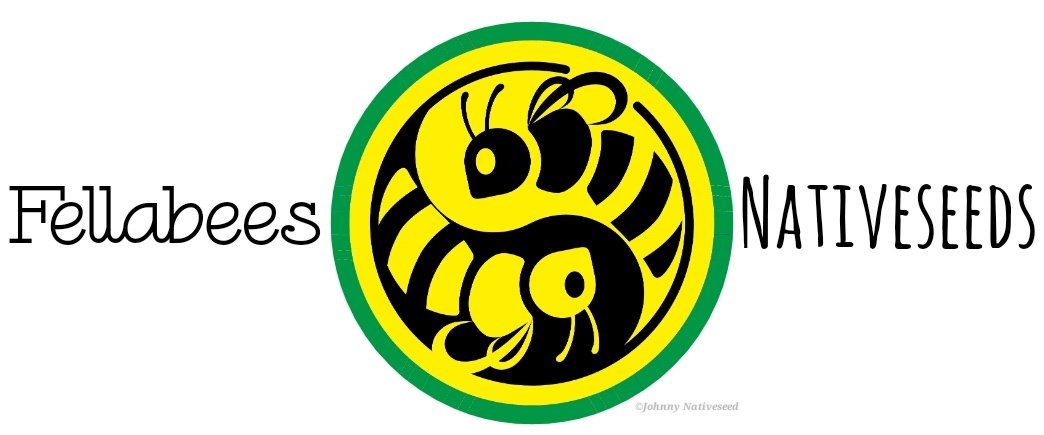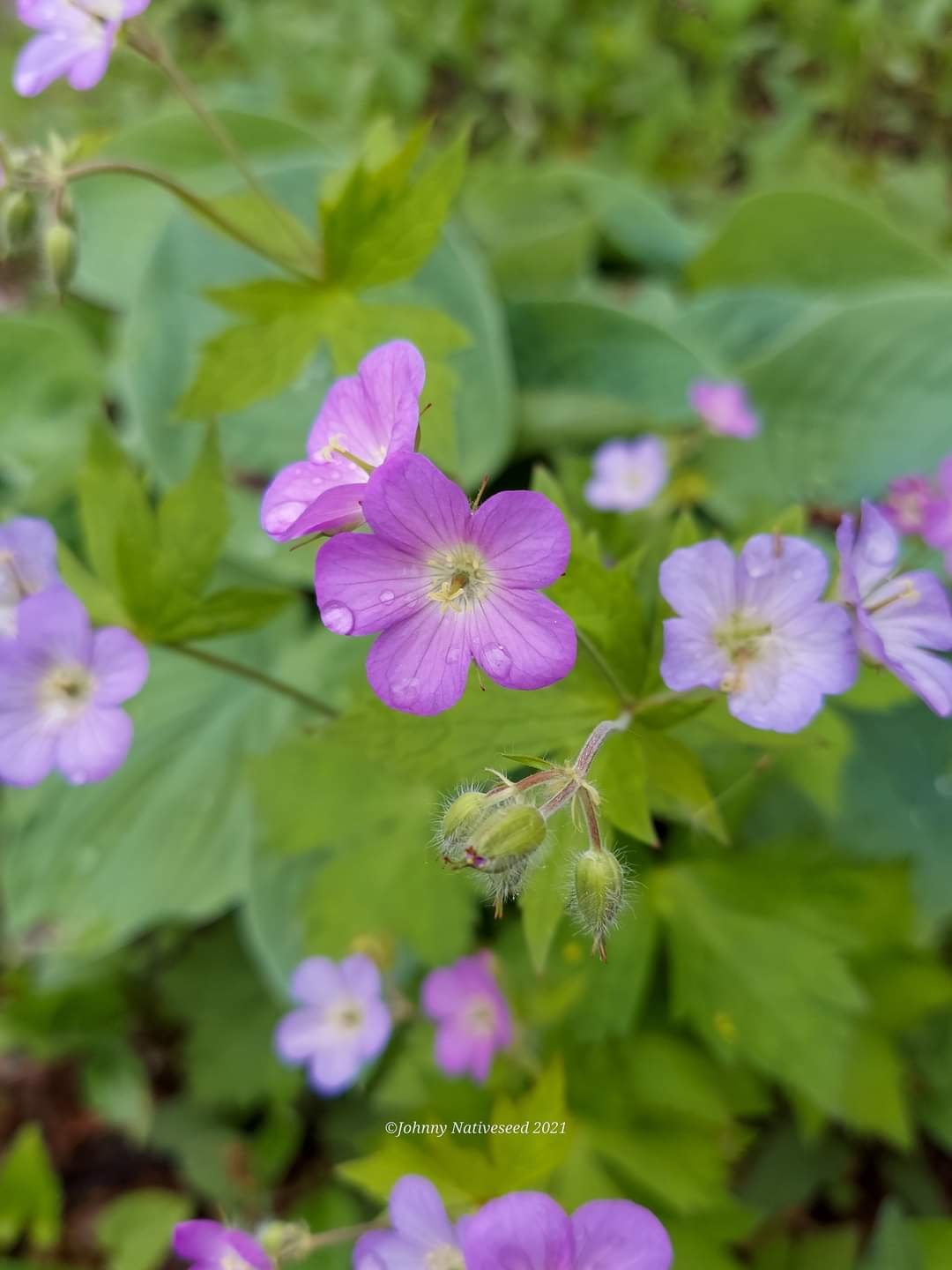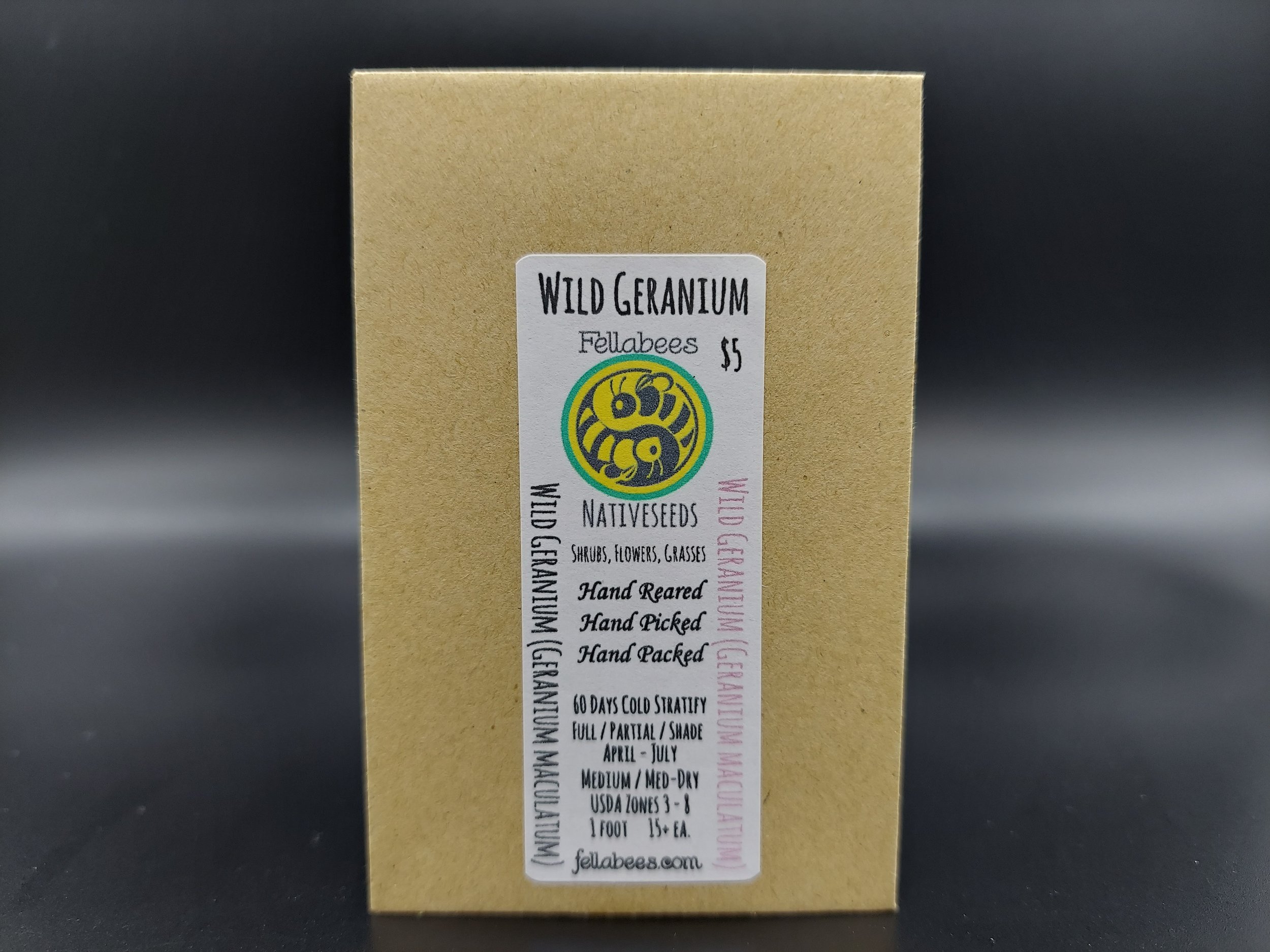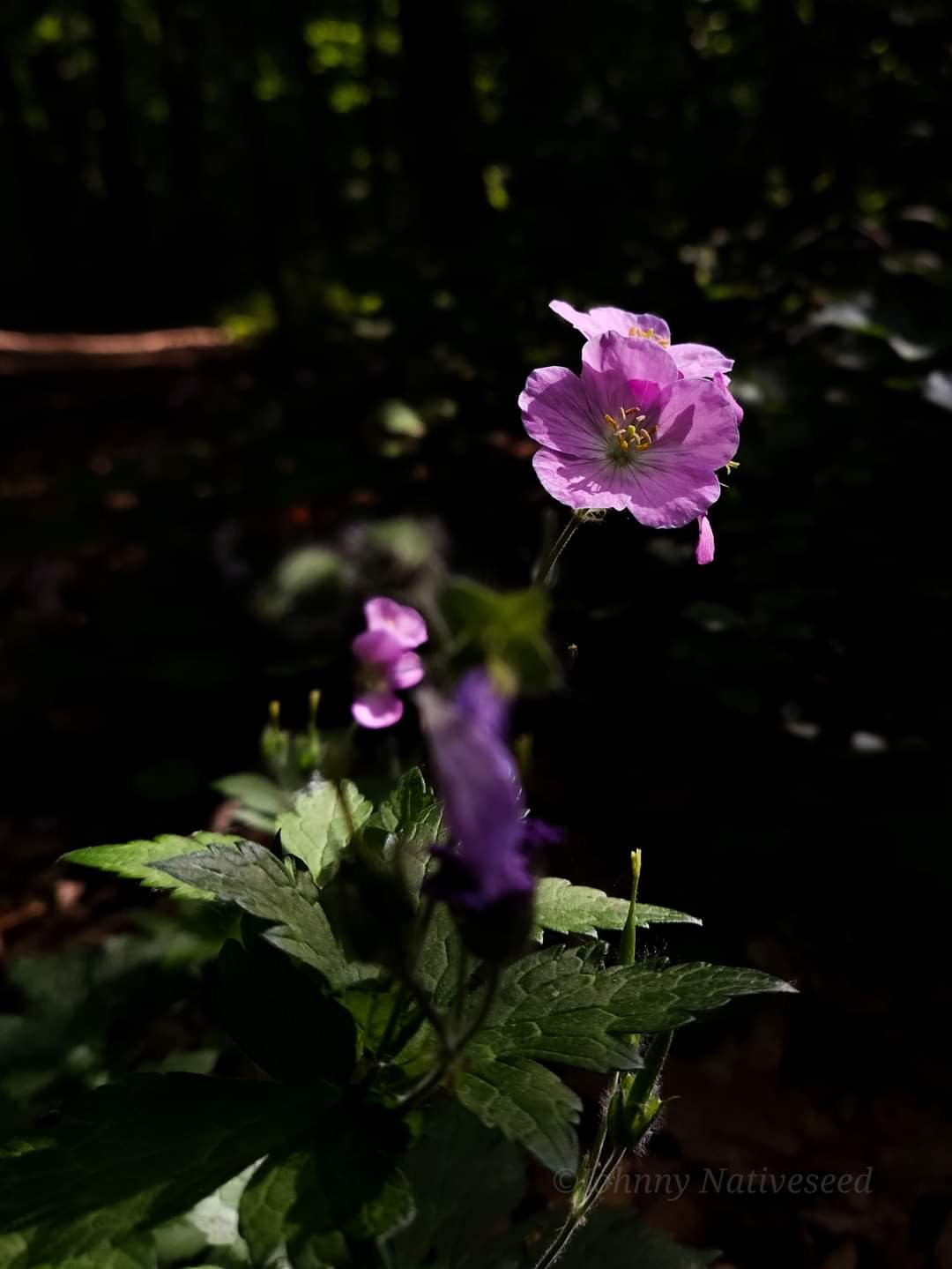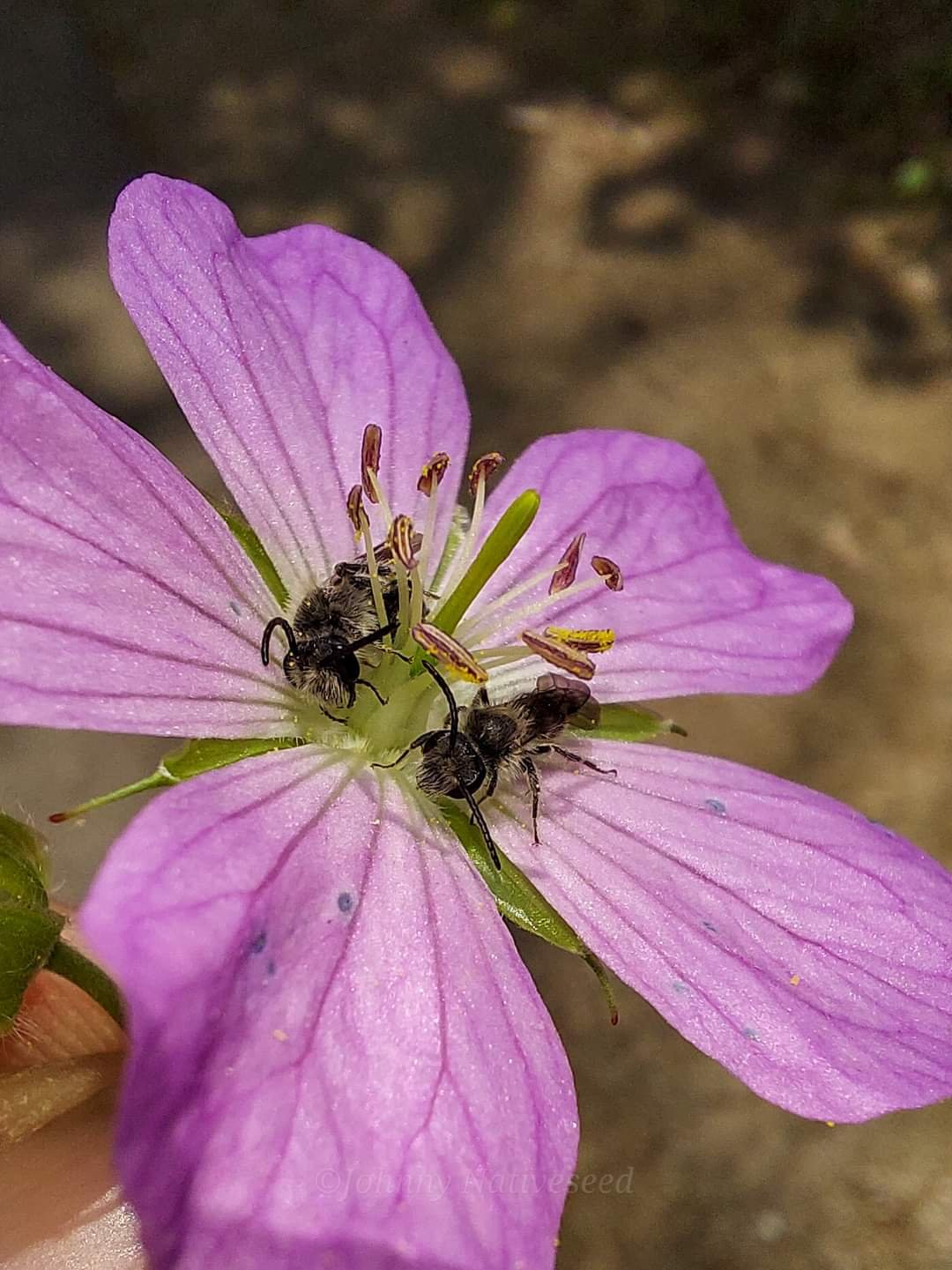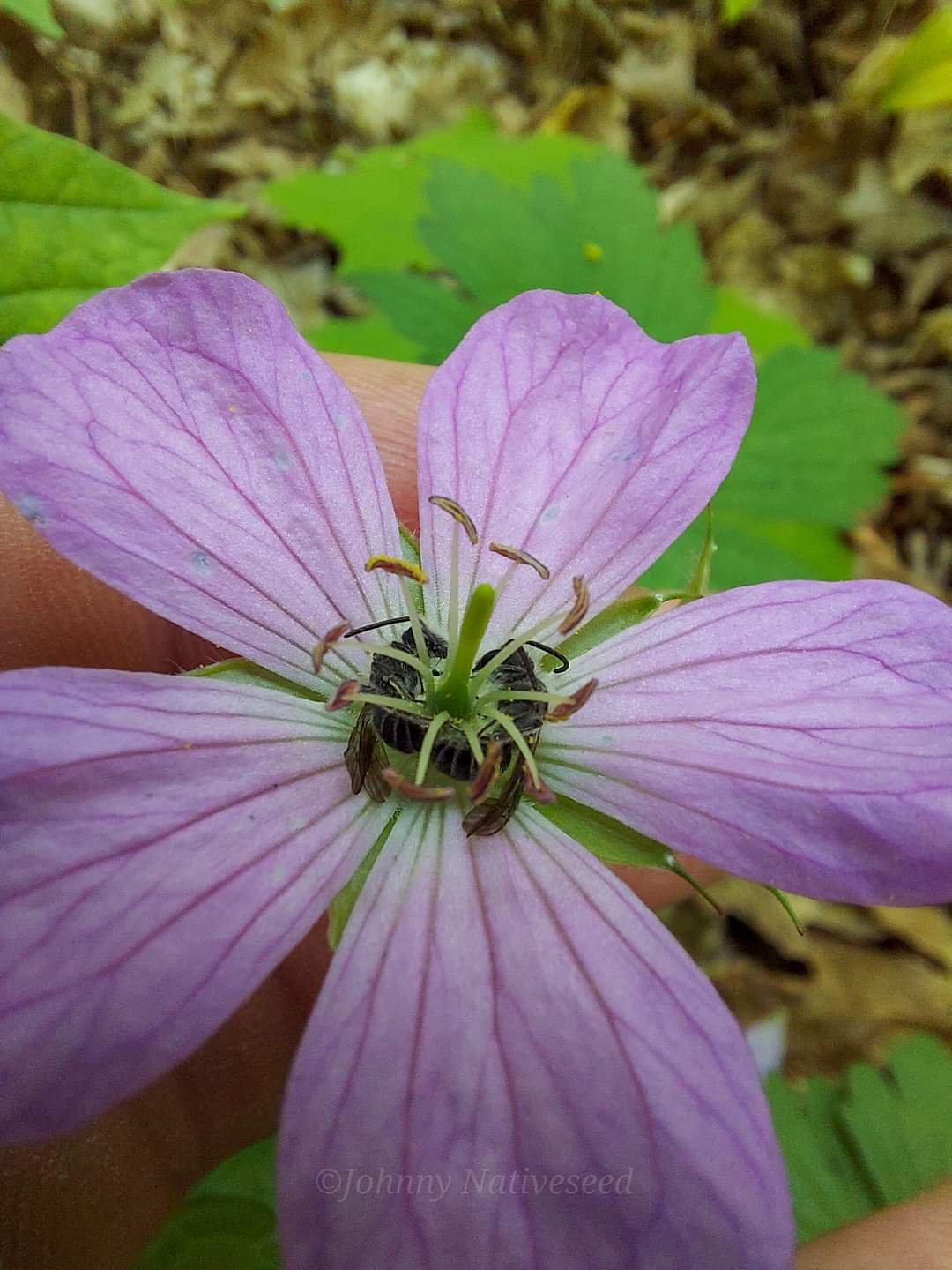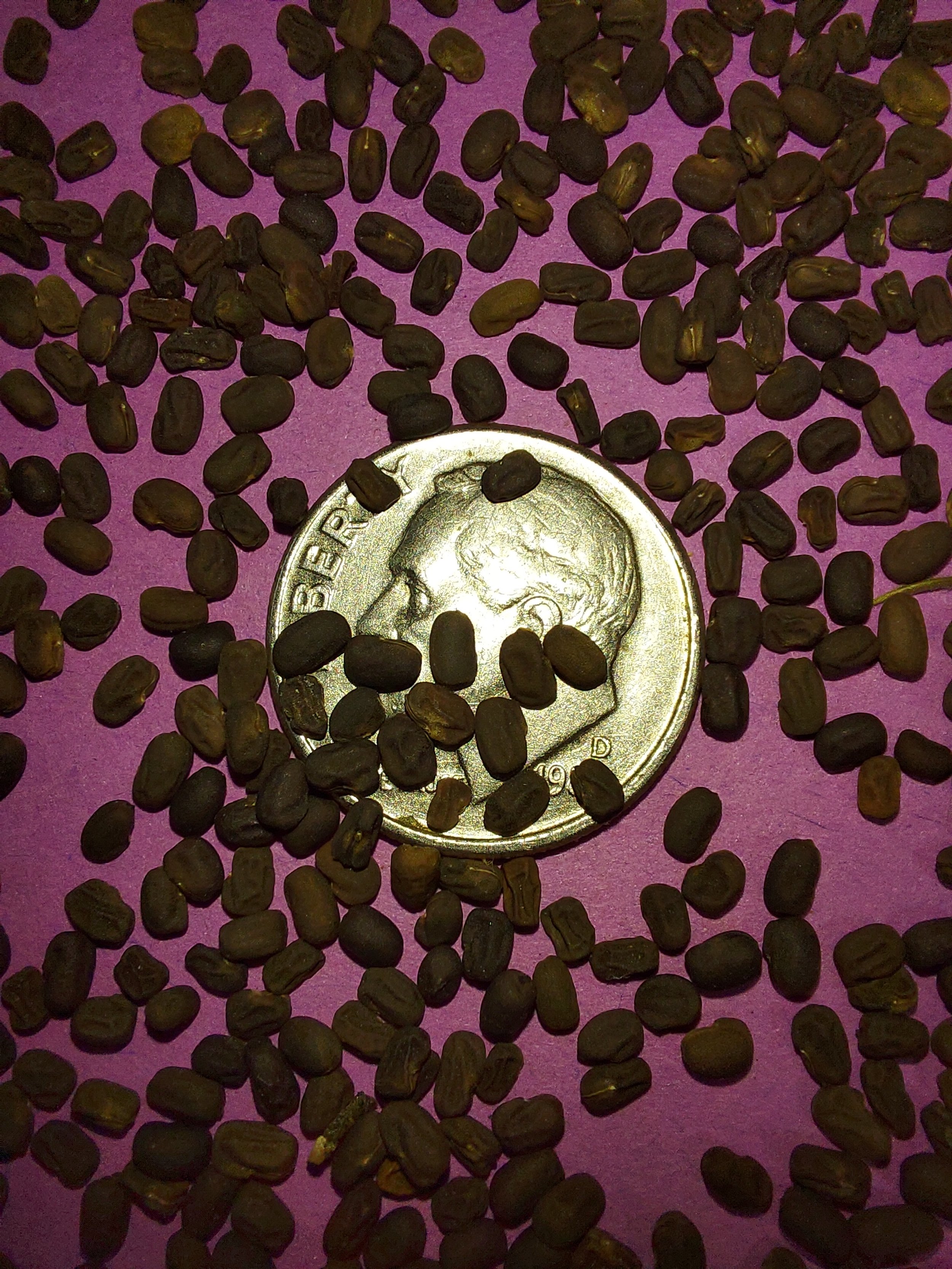Wild Geranium (Geranium maculatum)
Wild Geranium (Geranium maculatum)
Geranium maculatum is the scientific name for Wild Geranium. Also colloquially called Spotted Geranium, or Wood Geranium in various regions in which this sought after and prized early spring plant indicates the coming of summer.
WIld Geranium s a perennial plant native to woodland in eastern North America, from southern Manitoba and southwestern Quebec south to Alabama and Georgia and west to Oklahoma and South Dakota.
Found in every state bordering both sides of the Mississippi River and every state to the east coast, calling this native intrepid, would be an understatement of the woodland under-story.
The flowers of Wild Geranium are 1.0–1.6 inches in diameter, with five rose-purple, pale or violet-purple and even sometimes rarely white petals with ten stamens.
In the Northern Hemisphere, they appear from April to July (depending on the latitude). They are grouped in loose corymbs or umbels of two to five at the top of the flower stems.
The fruit capsule, which springs open when ripe, consists of five cells each containing one seed joined to a long beak-like column 0.8–1.2 inches long (resembling a crane's bill) produced from the center of the old flower.
The rhizome of Wild Geranium is long, and is 2 to 4 inches thick, with numerous branches. It is covered with scars, showing the remains of stems of previous years' growth. When dry it has a somewhat purplish color internally.
The plant has been used in herbal medicine, and is also grown as a garden plant. Wild Geranium is considered an astringent, a substance that causes contraction of the tissues and stops bleeding. The Meskwaki people brewed an effective root tea for toothache and for painful nerves as well as mashing the roots into a poultice for treating hemorrhoids.
No matter your light conditions Wild Geranium will do well in most soil conditions except for too wet or too dry.
Pollinators mob this plant as it blooms with copious pollen and nectar drawing in crowds of early spring butterflies and bees. Often male mining bees of the Andrena family can be found sleeping on the flowers and reluctant to be stirred until the temperatures warm their motivations in search of a mate.
The seed of Wild Geranium has a unique way of spreading that is similar to another low growing native called Wild Petunia (Ruellia humilis). Both are experts at catapulting their seed far from their parent plant, sometimes beyond 10 feet!
The seeds themselves are well engineered and have a tail-like structure that responds to humidity and temperatures which cause gyrations of the seeds tail which perfectly pulls or plunges the seed to a perfect spot for maximum germination potential!
It is this mechanism which enforces the general idea of fall sowing directly on the surface, or winte sowing in containers, but simply scattering the seed on the surface, as nature has always done!
Plant Details:
USDA Zones: 3-8
Germination Needs: 60 Days Cold Moist Stratification, does best if sown outdoors in late fall.
Life Cycle: Perennial
Sun Exposure: Full, Partial, Shade
Soil Moisture: Medium, Medium-Dry
Plant Spacing: 10-12 inches
Height: 1 foot
Bloom time: April, May, June, July
Bloom Color: Purple
Advantages :
Pollinator Favorite: butterflies, moths, bees, wasps, beetles
Bird Favorite: seeds, insects, fruit, nectar, nesting, perchs.
Deer Resistant: Yes
Excellent in the home landscape!
Native to : Wisconsin, Minnesota, Iowa, Illinois, Indiana, Michigan, Ohio, Pennsylvania, New York, Vermont, New Hampshire, Maine, Massachusetts, Rhode Island, Connecticut, Delaware, Maryland, New Jersey, West Virginia, Virginia, Kentucky, Tennessee, North Carolina, South Carolina, Georgia, Florida, Alabama, Mississippi, Louisiana, Arkansas, Missouri, Oklahoma, Kansas, Nebraska, South Dakota, and North Dakota.
This plant is listed as present but rare in several counties of Kansas, South Dakota Louisiana, and Florida. It is also listed as extirpated (locally extinct) in several counties of Nebraska and North Dakota.
.
.
Packet quantities:
We pride ourselves on ethical, hands on, ecological management, using no mechanical or chemical methods whatsoever.
All of our native seed is hand reared, hand picked, and hand packed from native prairies under our exclusive management, never breaking chain of custody from the field until it is sent to you. Each packet is hand prepared for shipment by us, directly.
Small seed species will contain greater than 12-25 seed (depending on rarity, and in house quantity)
Large seed species will contain greater than 10-15 seed
It is our mission to spread the wealth of native plant and pollinator ecological sustainability, and educate back yard gardeners as well as corporate and government entities in how to germinate, grow, and benefit from native synergies.
Thank you for your support, it is because of you, that we can grow together to do, what we do.🐛🦋🐝🐞🌾🌱🌼🧡
Wild Geranium (Geranium maculatum)
Geranium maculatum is the scientific name for Wild Geranium. Also colloquially called Spotted Geranium, or Wood Geranium in various regions in which this sought after and prized early spring plant indicates the coming of summer.
WIld Geranium s a perennial plant native to woodland in eastern North America, from southern Manitoba and southwestern Quebec south to Alabama and Georgia and west to Oklahoma and South Dakota.
Found in every state bordering both sides of the Mississippi River and every state to the east coast, calling this native intrepid, would be an understatement of the woodland under-story.
The flowers of Wild Geranium are 1.0–1.6 inches in diameter, with five rose-purple, pale or violet-purple and even sometimes rarely white petals with ten stamens.
In the Northern Hemisphere, they appear from April to July (depending on the latitude). They are grouped in loose corymbs or umbels of two to five at the top of the flower stems.
The fruit capsule, which springs open when ripe, consists of five cells each containing one seed joined to a long beak-like column 0.8–1.2 inches long (resembling a crane's bill) produced from the center of the old flower.
The rhizome of Wild Geranium is long, and is 2 to 4 inches thick, with numerous branches. It is covered with scars, showing the remains of stems of previous years' growth. When dry it has a somewhat purplish color internally.
The plant has been used in herbal medicine, and is also grown as a garden plant. Wild Geranium is considered an astringent, a substance that causes contraction of the tissues and stops bleeding. The Meskwaki people brewed an effective root tea for toothache and for painful nerves as well as mashing the roots into a poultice for treating hemorrhoids.
No matter your light conditions Wild Geranium will do well in most soil conditions except for too wet or too dry.
Pollinators mob this plant as it blooms with copious pollen and nectar drawing in crowds of early spring butterflies and bees. Often male mining bees of the Andrena family can be found sleeping on the flowers and reluctant to be stirred until the temperatures warm their motivations in search of a mate.
The seed of Wild Geranium has a unique way of spreading that is similar to another low growing native called Wild Petunia (Ruellia humilis). Both are experts at catapulting their seed far from their parent plant, sometimes beyond 10 feet!
The seeds themselves are well engineered and have a tail-like structure that responds to humidity and temperatures which cause gyrations of the seeds tail which perfectly pulls or plunges the seed to a perfect spot for maximum germination potential!
It is this mechanism which enforces the general idea of fall sowing directly on the surface, or winte sowing in containers, but simply scattering the seed on the surface, as nature has always done!
Plant Details:
USDA Zones: 3-8
Germination Needs: 60 Days Cold Moist Stratification, does best if sown outdoors in late fall.
Life Cycle: Perennial
Sun Exposure: Full, Partial, Shade
Soil Moisture: Medium, Medium-Dry
Plant Spacing: 10-12 inches
Height: 1 foot
Bloom time: April, May, June, July
Bloom Color: Purple
Advantages :
Pollinator Favorite: butterflies, moths, bees, wasps, beetles
Bird Favorite: seeds, insects, fruit, nectar, nesting, perchs.
Deer Resistant: Yes
Excellent in the home landscape!
Native to : Wisconsin, Minnesota, Iowa, Illinois, Indiana, Michigan, Ohio, Pennsylvania, New York, Vermont, New Hampshire, Maine, Massachusetts, Rhode Island, Connecticut, Delaware, Maryland, New Jersey, West Virginia, Virginia, Kentucky, Tennessee, North Carolina, South Carolina, Georgia, Florida, Alabama, Mississippi, Louisiana, Arkansas, Missouri, Oklahoma, Kansas, Nebraska, South Dakota, and North Dakota.
This plant is listed as present but rare in several counties of Kansas, South Dakota Louisiana, and Florida. It is also listed as extirpated (locally extinct) in several counties of Nebraska and North Dakota.
.
.
Packet quantities:
We pride ourselves on ethical, hands on, ecological management, using no mechanical or chemical methods whatsoever.
All of our native seed is hand reared, hand picked, and hand packed from native prairies under our exclusive management, never breaking chain of custody from the field until it is sent to you. Each packet is hand prepared for shipment by us, directly.
Small seed species will contain greater than 12-25 seed (depending on rarity, and in house quantity)
Large seed species will contain greater than 10-15 seed
It is our mission to spread the wealth of native plant and pollinator ecological sustainability, and educate back yard gardeners as well as corporate and government entities in how to germinate, grow, and benefit from native synergies.
Thank you for your support, it is because of you, that we can grow together to do, what we do.🐛🦋🐝🐞🌾🌱🌼🧡
Wild Geranium (Geranium maculatum)
Geranium maculatum is the scientific name for Wild Geranium. Also colloquially called Spotted Geranium, or Wood Geranium in various regions in which this sought after and prized early spring plant indicates the coming of summer.
WIld Geranium s a perennial plant native to woodland in eastern North America, from southern Manitoba and southwestern Quebec south to Alabama and Georgia and west to Oklahoma and South Dakota.
Found in every state bordering both sides of the Mississippi River and every state to the east coast, calling this native intrepid, would be an understatement of the woodland under-story.
The flowers of Wild Geranium are 1.0–1.6 inches in diameter, with five rose-purple, pale or violet-purple and even sometimes rarely white petals with ten stamens.
In the Northern Hemisphere, they appear from April to July (depending on the latitude). They are grouped in loose corymbs or umbels of two to five at the top of the flower stems.
The fruit capsule, which springs open when ripe, consists of five cells each containing one seed joined to a long beak-like column 0.8–1.2 inches long (resembling a crane's bill) produced from the center of the old flower.
The rhizome of Wild Geranium is long, and is 2 to 4 inches thick, with numerous branches. It is covered with scars, showing the remains of stems of previous years' growth. When dry it has a somewhat purplish color internally.
The plant has been used in herbal medicine, and is also grown as a garden plant. Wild Geranium is considered an astringent, a substance that causes contraction of the tissues and stops bleeding. The Meskwaki people brewed an effective root tea for toothache and for painful nerves as well as mashing the roots into a poultice for treating hemorrhoids.
No matter your light conditions Wild Geranium will do well in most soil conditions except for too wet or too dry.
Pollinators mob this plant as it blooms with copious pollen and nectar drawing in crowds of early spring butterflies and bees. Often male mining bees of the Andrena family can be found sleeping on the flowers and reluctant to be stirred until the temperatures warm their motivations in search of a mate.
The seed of Wild Geranium has a unique way of spreading that is similar to another low growing native called Wild Petunia (Ruellia humilis). Both are experts at catapulting their seed far from their parent plant, sometimes beyond 10 feet!
The seeds themselves are well engineered and have a tail-like structure that responds to humidity and temperatures which cause gyrations of the seeds tail which perfectly pulls or plunges the seed to a perfect spot for maximum germination potential!
It is this mechanism which enforces the general idea of fall sowing directly on the surface, or winte sowing in containers, but simply scattering the seed on the surface, as nature has always done!
Plant Details:
USDA Zones: 3-8
Germination Needs: 60 Days Cold Moist Stratification, does best if sown outdoors in late fall.
Life Cycle: Perennial
Sun Exposure: Full, Partial, Shade
Soil Moisture: Medium, Medium-Dry
Plant Spacing: 10-12 inches
Height: 1 foot
Bloom time: April, May, June, July
Bloom Color: Purple
Advantages :
Pollinator Favorite: butterflies, moths, bees, wasps, beetles
Bird Favorite: seeds, insects, fruit, nectar, nesting, perchs.
Deer Resistant: Yes
Excellent in the home landscape!
Native to : Wisconsin, Minnesota, Iowa, Illinois, Indiana, Michigan, Ohio, Pennsylvania, New York, Vermont, New Hampshire, Maine, Massachusetts, Rhode Island, Connecticut, Delaware, Maryland, New Jersey, West Virginia, Virginia, Kentucky, Tennessee, North Carolina, South Carolina, Georgia, Florida, Alabama, Mississippi, Louisiana, Arkansas, Missouri, Oklahoma, Kansas, Nebraska, South Dakota, and North Dakota.
This plant is listed as present but rare in several counties of Kansas, South Dakota Louisiana, and Florida. It is also listed as extirpated (locally extinct) in several counties of Nebraska and North Dakota.
.
.
Packet quantities:
We pride ourselves on ethical, hands on, ecological management, using no mechanical or chemical methods whatsoever.
All of our native seed is hand reared, hand picked, and hand packed from native prairies under our exclusive management, never breaking chain of custody from the field until it is sent to you. Each packet is hand prepared for shipment by us, directly.
Small seed species will contain greater than 12-25 seed (depending on rarity, and in house quantity)
Large seed species will contain greater than 10-15 seed
It is our mission to spread the wealth of native plant and pollinator ecological sustainability, and educate back yard gardeners as well as corporate and government entities in how to germinate, grow, and benefit from native synergies.
Thank you for your support, it is because of you, that we can grow together to do, what we do.🐛🦋🐝🐞🌾🌱🌼🧡
